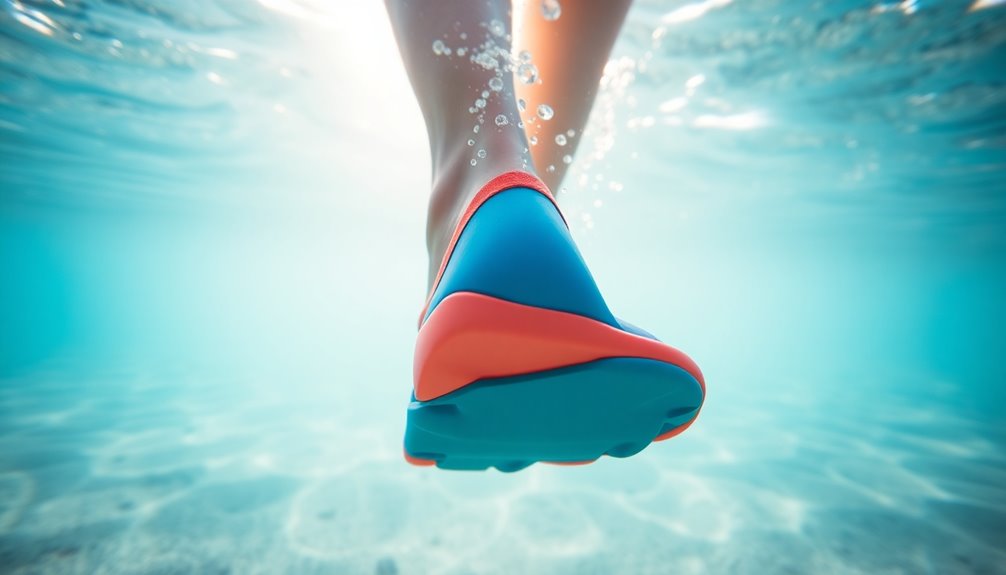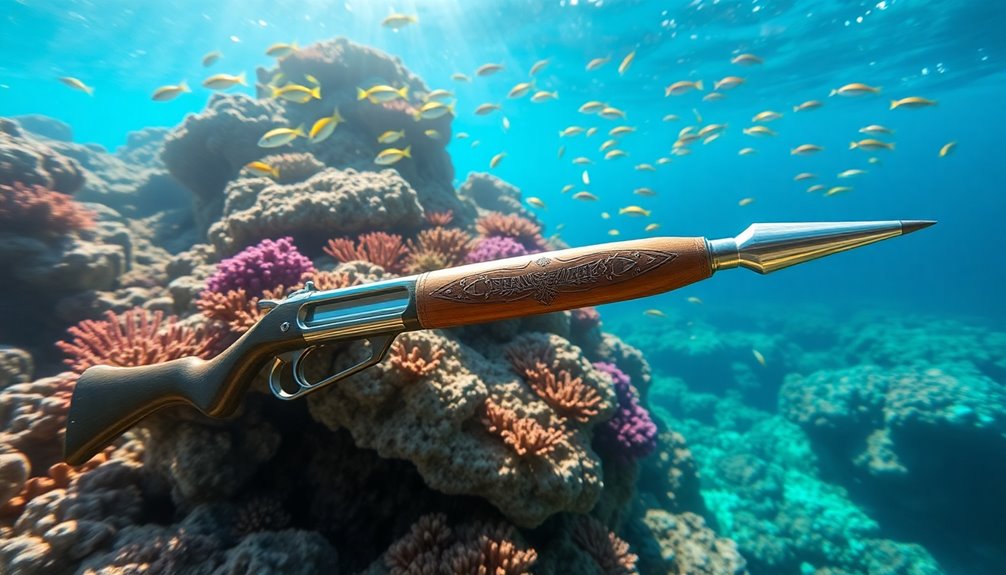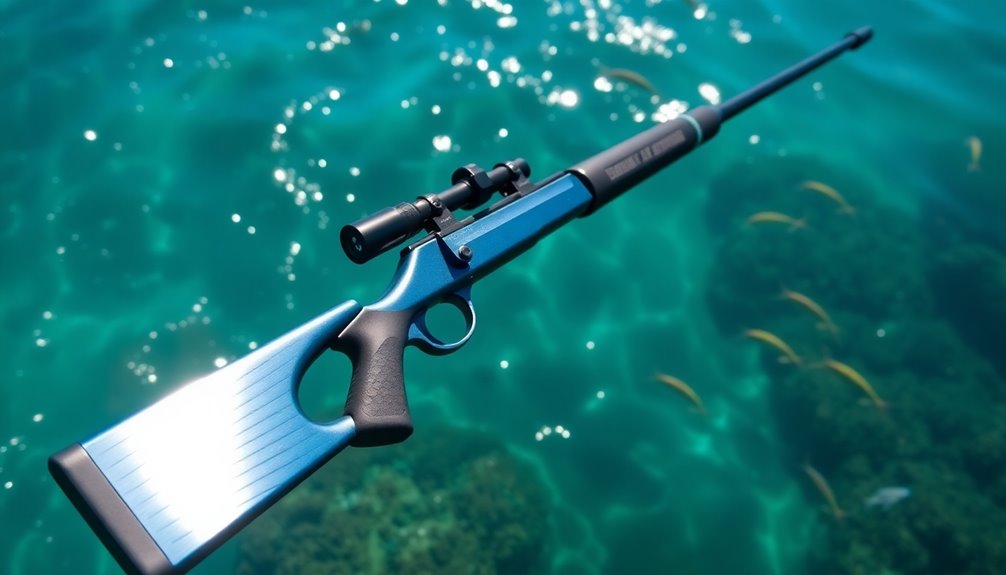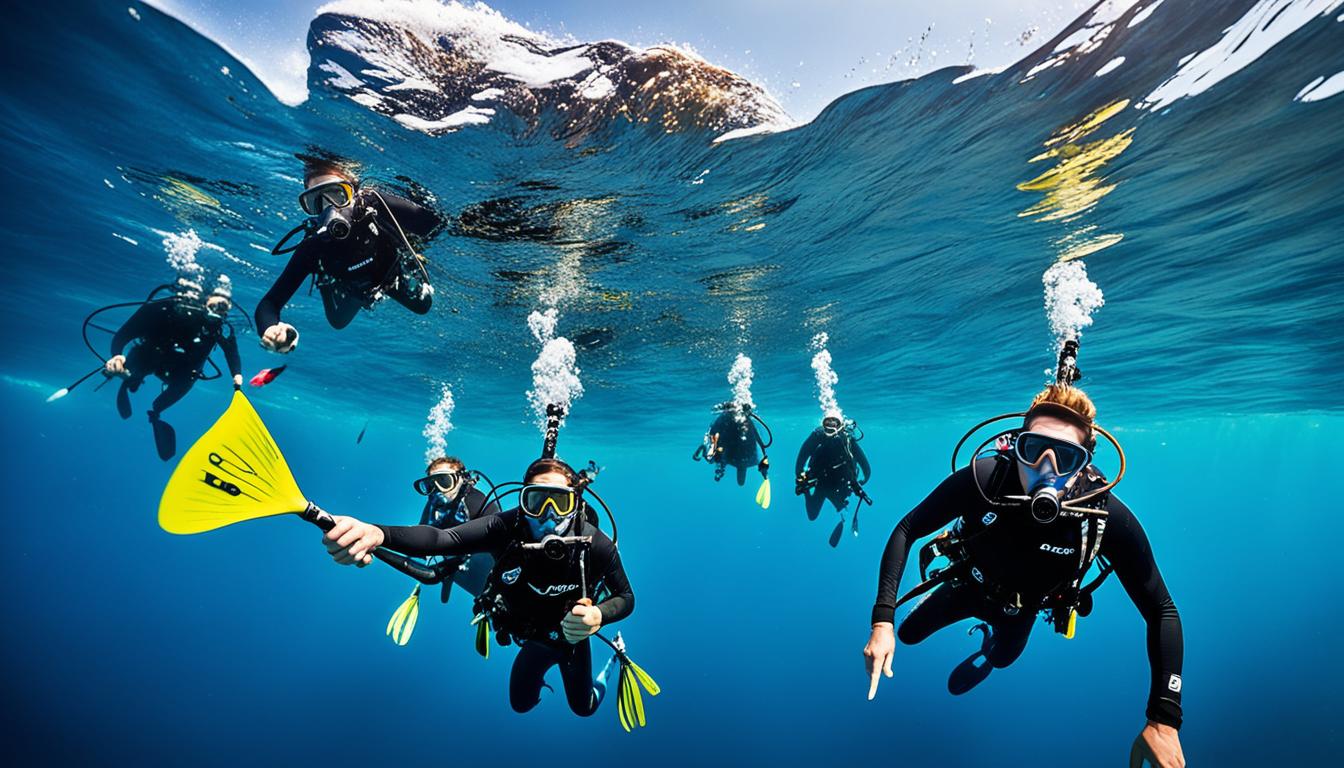Foot pockets are super important for your kicks underwater! They should fit snugly, hugging your feet for better energy transfer to your fins. A great foot pocket keeps you comfy, preventing blisters and fatigue during long dives. There are two main types: full-foot and open-heel. Full-foot pockets are perfect for warm water, while open-heel ones work well with dive booties in cooler water. When foot pockets fit right, they reduce drag and help you swim efficiently. So, make sure yours is cozy and compatible! Keep exploring, and you'll discover even more ways to enhance your underwater adventures!
Key Takeaways
- A snug fit in foot pockets ensures efficient energy transfer from your legs to the fins, enhancing kick performance underwater.
- Comfort features like soft rubber tops help prevent blisters and hot spots, allowing for longer, more enjoyable dives.
- Full-foot pockets are ideal for warm water, while open-heel pockets allow for customization with dive booties in colder conditions.
- Regular maintenance, including rinsing and inspection, prolongs the durability of foot pockets, ensuring consistent performance over time.
- Proper alignment between foot pockets and fin blades minimizes drag, improving hydrodynamics and overall diving efficiency.
Importance of Fit and Comfort
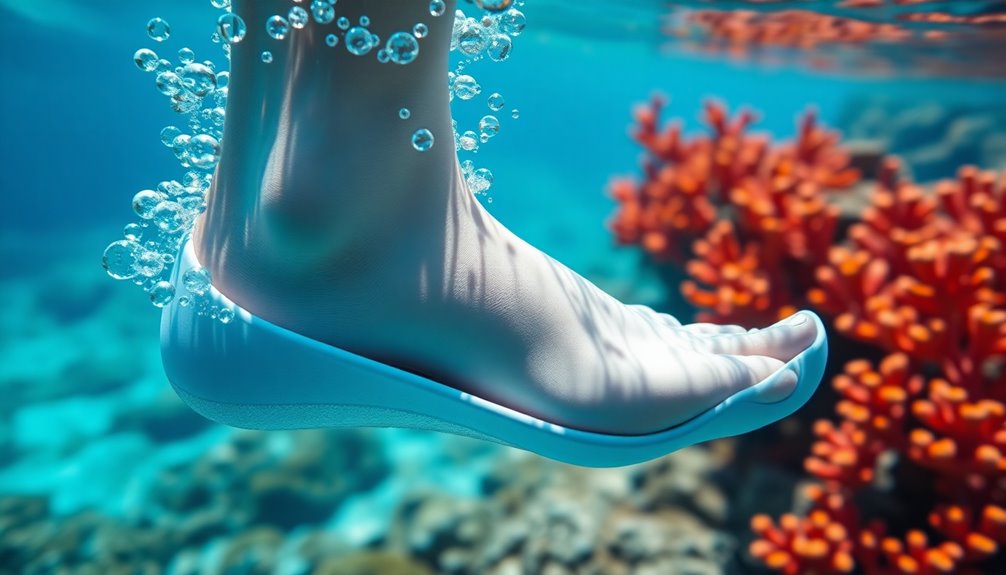
When it comes to selecting fins, fit and comfort are crucial for a successful diving experience. You want your foot pockets to hug your feet snugly, like your favorite pair of shoes. This close fit ensures that energy transfers smoothly to the blades, helping you swim efficiently. If the fit is too loose, you might find yourself fighting against drag, making each kick feel harder than it should.
Comfort matters too! A soft rubber top on the foot pocket can make all the difference during long dives. You don't want blisters or hot spots ruining your underwater adventure. Remember, if you wear neoprene socks or booties, make sure to account for that extra thickness when choosing your fins.
Also, check the anatomical design of the fins. Full foot fins fit closely and reduce bulk, which means less drag. You can easily test the fit by pointing your toes and ensuring there aren't any gaps. It's important to note that the proper sizing of foot pockets is essential for achieving optimal performance.
A snug, comfortable fit lets you feel like your fins are an extension of your feet, making your kicks powerful and enjoyable. Happy diving!
Factors Affecting Durability
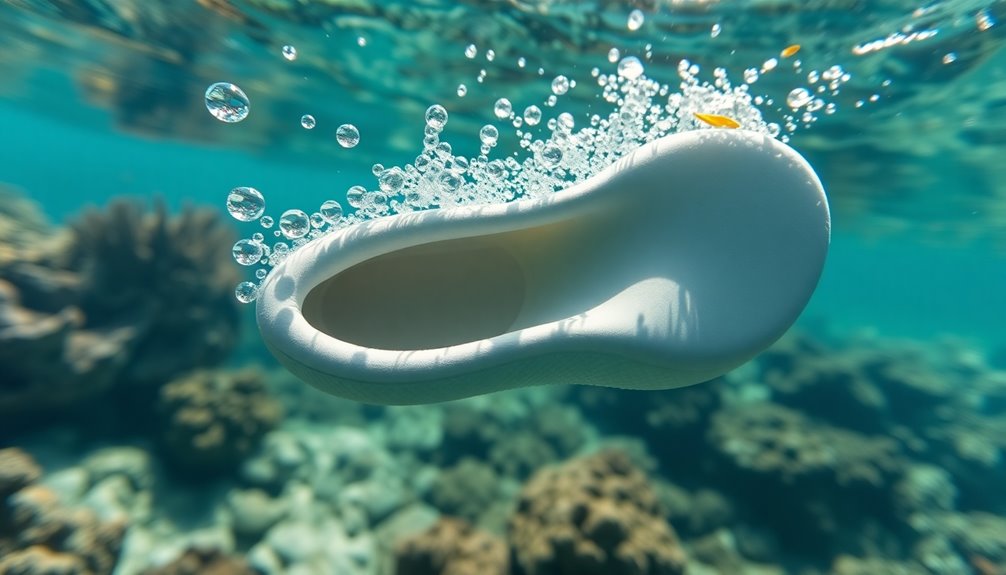
Choosing the right fins involves more than just fit and comfort; durability plays a significant role in your diving experience. To keep your fins lasting longer, pay attention to the materials. Softer rubber feels great but wears out faster, while harder rubber lasts longer. Natural rubber is super durable but heavier, so finding a balance is key.
Synthetic materials are lighter and often used in modern fins like the OMER Stingray, making them a popular choice. Another important factor is bottom stiffness. If the bottom is too soft, it can slow you down and make it hard for energy to transfer efficiently. You want a moderate stiffness to stabilize the fin and help water flow smoothly.
Don't forget about tendon stiffness either! It affects how the fin moves. Moderate stiffness supports the blade without being too stiff, which can feel uncomfortable. Furthermore, having good time management skills when selecting fins can help ensure that you make thoughtful choices and avoid rushing the decision.
Finally, consider the weight and material density. Heavier materials may be durable, but lighter ones can make your dives more enjoyable. Balancing weight and durability will help you enjoy every kick underwater, so dive in and find the perfect fins for your adventures!
Ensuring Blade Compatibility
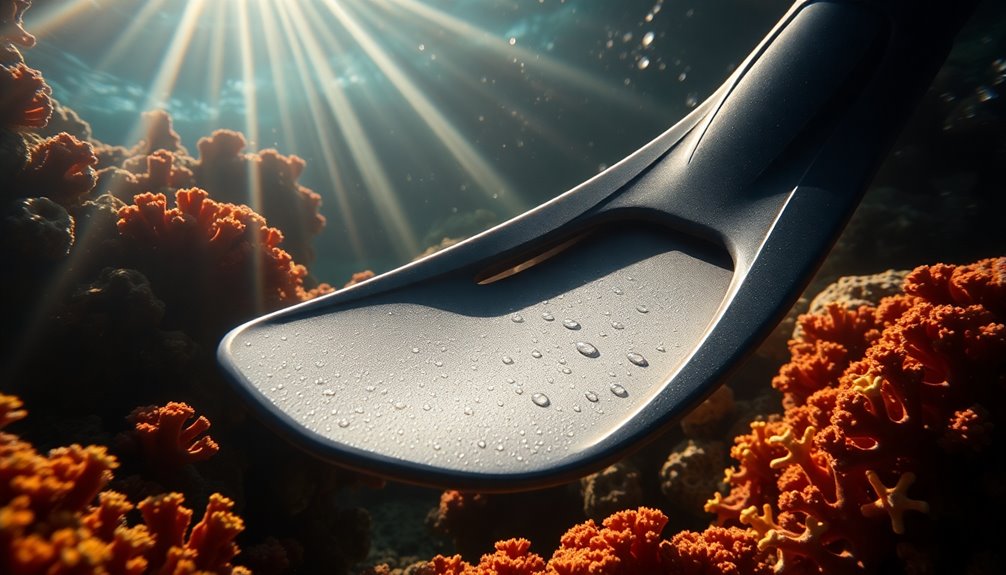
Ensuring blade compatibility is essential for a seamless diving experience. You want your blades to fit snugly in the foot pocket, so start by lining the base of the blade up with the bottom of the foot pocket. Then, push the blade in and check for a tight fit. If it seems a bit loose, don't hesitate to use some force to secure it. A snug fit is key for making your kicks efficient underwater!
Remember, the foot pocket should closely hug your foot to avoid wasting energy. Soft material on top keeps your feet comfortable, while a stiff bottom holds the blade in place. You can also bend the foot pocket rails slightly to ensure the blade sits correctly. Upgrading gear is essential for enhancing your diving performance and efficiency.
To keep everything secure, consider using a fin fixing kit. You can permanently glue the blade or use screws for flexibility later. Just make sure all connections are tight.
If the blade and foot pocket don't match perfectly, some adjustments might be needed. Getting this right means you'll have a fantastic diving experience, allowing you to focus on enjoying your underwater adventures!
Hydrodynamics and Performance
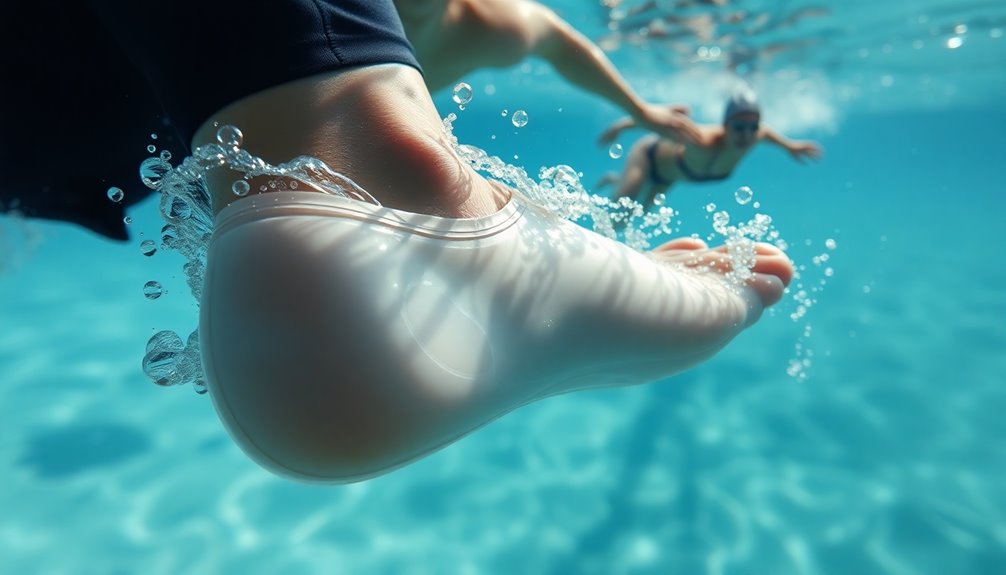
Hydrodynamics plays a crucial role in optimizing your diving performance, and foot pockets are no exception. When you swim or dive, the design of your foot pockets can make a big difference. They should be shaped to reduce drag and help you move smoothly through the water. Using smooth, water-repellent materials is key. Just like a well-made swimsuit, they help cut down on water resistance.
As you kick, water flows around your feet, speeding up your movements. This is especially true during dolphin kicks, where the water creates powerful vortexes that push you forward. A well-fitted foot pocket enhances this effect, allowing you to swim faster with less effort. Recent research has shown that increased swimming speed correlates with higher water-flow velocity, which can be further optimized with proper foot pocket design.
Comfort matters too! If your foot pockets fit snugly, they'll feel like an extension of your feet. A good fit prevents blisters, allowing you to focus on your technique.
Lastly, the quality of materials can't be overlooked. The right balance of rubber makes sure your foot pockets are both comfy and durable.
With the proper foot pockets, you’re set for an exciting underwater adventure, gliding through the water effortlessly! Additionally, a freediving wetsuit that fits snugly can help maintain your body heat and keep you comfortable while exploring the depths. The right gear is crucial for a successful and enjoyable dive, so it’s important to invest in high-quality equipment. With the right tools and knowledge, you can experience the wonders of the underwater world in the safest and most enjoyable way possible.
Testing Methods for Selection
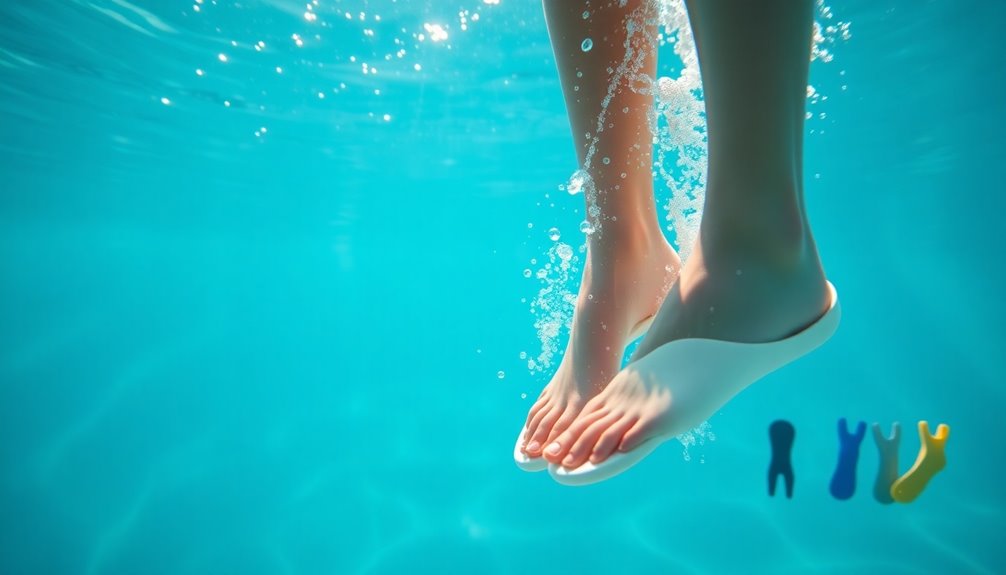
When it comes to selecting the right foot pockets for diving, testing methods are essential to ensure comfort and performance. You want to make sure your feet feel great while swimming underwater! One fun way to test sensitivity is by using a special tool called a monofilament. You hold it against your foot for a moment and see if you can feel it. It's a simple way to check how well your feet can sense things.
Before starting, make sure you're in a calm, quiet place. It's also important to clean your hands and wear gloves.
When you're ready, close your eyes and let someone test different spots on your foot. They'll ask you to say "yes" whenever you feel the touch. If you don't feel it the first time, they can try again.
After testing, write down how many spots you felt. This helps you understand if your foot pockets fit just right! Additionally, incorporating comprehensive assessments of foot sensitivity can enhance your overall experience and performance while diving.
Types of Foot Pockets

Choosing the right type of foot pocket can significantly enhance your diving experience. There are two main types: full-foot pockets and open-heel pockets.
Full-foot pockets cover your entire foot, including your heel. They fit snugly and can be worn without dive booties, making them perfect for warm water diving. They're lightweight and compact, so they're great for travel too! Proper fit is crucial for enhancing propulsion and overall fin performance, ensuring you have an enjoyable dive experience.
On the other hand, open-heel pockets leave your heel exposed and use straps to hold your foot in place. You wear them with dive booties, which keep your feet warm in colder waters. Plus, you can adjust them to fit different thicknesses of booties, giving you more flexibility.
When picking a foot pocket, remember that a snug fit is key! It helps you swim efficiently and avoid blisters. Soft materials on top can make them comfortable, while durable rubber is important for long-lasting use. The right pocket keeps your foot secure underwater, allowing you to focus on enjoying your dive.
Frequently Asked Questions
How Often Should I Inspect My Foot Pockets for Wear?
You should inspect your foot pockets regularly, ideally before each dive, to catch any signs of wear.
Look for cracks, dry rot, or worn straps. These checks help keep your fins in top shape!
When you notice any damage, it's best to replace those parts right away.
Taking care of your gear means more comfort and efficiency underwater, so make it a fun routine to check your fins before every adventure!
Can I Use Foot Pockets With Different Fin Brands?
Yes, you can use foot pockets with different fin brands, but it's important to check their compatibility first.
Some brands fit together perfectly, while others might not. You'll want to consider factors like the stiffness of the foot pocket and how well they match with the fins.
Trying different combinations can lead to exciting discoveries, but make sure to look for reviews.
Happy swimming, and enjoy finding the perfect fit for your kicks!
What Materials Are Commonly Used in Foot Pockets?
Foot pockets are made from several exciting materials!
You'll often find synthetic options, like polyurethane, which are super light and durable. Natural rubber is traditional and offers great support but can feel a bit heavy.
Silicone is a newer choice that's comfy and fits many foot shapes. Some foot pockets even use hybrid materials, mixing different options to create the best performance.
Each material helps you kick efficiently and enjoy your underwater adventures!
Do Foot Pockets Affect My Buoyancy When Diving?
Foot pockets don't really affect your buoyancy when diving.
They're designed more for comfort and efficiency than for floating. While they help you kick better, other factors matter much more.
Things like your wetsuit, tank, and weights play a big role in keeping you balanced underwater.
So, when you're diving, focus on adjusting those gear pieces instead.
Just remember, good body position is super important for staying even in the water!
Are There Foot Pocket Options for Larger Shoe Sizes?
Yes, there are foot pocket options for larger shoe sizes!
Many brands offer various sizes, so you can find the perfect fit. It's important to check their size charts, which often match shoe sizes.
If you wear thicker neoprene socks or booties, you might need to choose a larger foot pocket size. A snug fit is key, as it helps prevent blisters while ensuring comfort and efficiency when you're swimming or diving!
Conclusion
Choosing the right foot pocket makes all the difference when you're swimming! It keeps your feet comfy and helps you move smoothly through the water. Remember to think about fit, durability, and how well it works with your fins. With the right foot pocket, you'll enjoy more fun underwater adventures! So, dive in, explore the different types, and find the perfect match for you. You'll be gliding through the waves in no time! Happy swimming!

